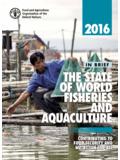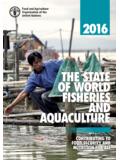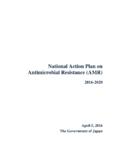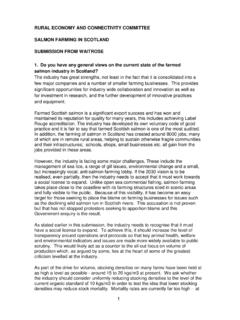Transcription of Fishmeal and fish oil facts and figures
1 Contents Page List of tables 2 1. Fishmeal and fish oil summary 3 2. world food and feed fisheries and aquaculture key figures 4 3. world production, supply and consumption of Fishmeal 5 4. world production, supply and consumption of fish oil 14 5. EUROPEAN production, supply and consumption of Fishmeal and fish oil 17 6. UK production, supply and use of Fishmeal and fish oil 20 Fishmeal and fish oil to: 7a farmed land animals 7b farmed fish ( aquaculture ) 24 27 Compiled by Seafish (with thanks to the Marine Ingredients Organisation (IFFO) for permission to use its data). For further information contact: Karen Green Industry Issues and Communications Sea fish Industry Authority E: W: This is an information service provided by Seafish for industry and key stakeholders.
2 The views expressed are not necessarily the views of Seafish. The data presented is the most up-to-date that is accessible. Fishmeal and fish oil facts and figures December 2016 Fishmeal and fish oil facts and figures . December 2016. 2 List of tables Page world - world Fishmeal production 2006 - 2015 6 Total world production of Fishmeal 1998 to 2015 6 Global supply of Fishmeal 1997 to 2015 7 Fishmeal production by top 15 countries 2008 to 2015 7 Fishmeal production overview of raw material used 8 Fishmeal production raw material used 8 Fishmeal production raw material from by-product 9 Fishmeal production main species used 9 Fishmeal production main species used 2013 9 Key feed manufacturers species used in Fishmeal production Biomar, Skretting and EWOS.
3 2015 10 Changing uses of Fishmeal from land animal feed to fish feed 1960 to 2010 11 world Fishmeal market use by sector 2005 2015 11 world Fishmeal market use by sector in 2015 12 Fishmeal exports by top 15 countries 2008 to 2015 12 Fishmeal imports by top 15 countries 2008 to 2015 13 Composition of 1st, 2nd and 3rd grade Fishmeal 13 world fish oil production 2006 - 2015 14 fish oil production by top 15 countries 2008 to 2015 14 Key feed manufacturers species used in fish oil production Biomar and Skretting, 2015 15 world fish oil market use by sector in 2015 16 world fish oil market use by sector 2005 2015 16 EUROPEAN - European Fishmeal production 2006 to 2014 18 European Fishmeal production 2010 to 2015 18 European Fishmeal consumption 2009 (EU-27 + Norway)
4 19 European fish oil production 2010 to 2015 19 UK - Summary of UK Fishmeal imports 2009 to 2015 20 Summary of UK Fishmeal supply 2002 to 2008 21 Sources of UK Fishmeal imports 2000 to 2008 21 Fishmeal consumption and imports - UK 1996 to 2008 21 Feed grade fish stocks used to produce Fishmeal and fish oil 22 Summary of UK fish oil imports 2011 to 2015 23 ANIMAL FEED - Basic nutritive characteristics of various protein concentrates 25 Recommended rates of inclusion in diets for optimum benefit (pig and poultry feed) 25 Amino acid composition Fishmeal /other protein sources 26 A comparison of Fishmeal with other protein sources 26 Feed conversion comparison 26 aquaculture FEED - Use of Fishmeal in aquaculture in 2015 27 Use of fish oil in aquaculture in 2015 27 Dietary inclusion of Fishmeal (%)
5 In aquaculture feeds 1995 2011 28 Share of Fishmeal in feed ratio- world average 1991 - 2025 28 Fishmeal and fish oil consumption relative to growth of fed aquaculture 2000 - 2010 29 Declining Fishmeal inclusion rates in salmon diets 29 Marine ingredient inclusion in salmonid diets 30 Salmonid feed moving forward 30 Share of trimmings and byproducts in EWOS Fishmeal and fish oil in salmon diets 30 Changing composition of salmon feeds Fishmeal and fish oil substitution 31 Use of marine ingredients in Norwegian salmon feed 2010 2013 31 BioMar, Skretting and EWOS FFDR 32 Estimated changes to Whole fish in: whole fish out (FIFO) ratios (mass balance) 32 Development of FIFO and FFDR values for Fishmeal in Norwegian salmon farming 1990-2013 33 Development of FIFO and FFDR values for fish oil in Norwegian salmon farming 1990-2013.
6 33 Fishmeal and fish oil facts and figures . December 2016. 3 1. Fishmeal and fish oil summary MANUFACTURE Fishmeal is the crude flour obtained after milling and drying fish or fish parts, while fish oil is usually a clear brown/yellow liquid obtained through the pressing of the cooked fish . Many different species are used for Fishmeal and fish oil production, with oily fish , especially anchoveta, the main groups of species utilised. A significant, but declining, proportion of world fisheries production is processed into Fishmeal and fish oil thereby contributing indirectly to human consumption when they are used as feed in aquaculture and livestock raising. Fishmeal (FM) and fish oil (FO) are produced mainly from sustainably managed stocks of fish for which there is little or no demand for human consumption.
7 Non official estimates of the contribution of fish by-products and processing waste, rather than whole fish , to the total volume of FM and FO produced indicate it is now about 25-35% and this figure is expected to grow. These two fish products are manufactured in EU approved dedicated manufacturing plant and through a safety monitored supply chain. FM is never produced in the same factories as meat and bone meal. There are three different products sold as meal: High quality - usually for small-scale aquaculture units (trout farms) or marine species. LT (low temperature) meal - is highly digestible and used in salmon and piglet production. Prime FAQ (fair average quality) - lower protein content feed ingredient for pigs and poultry.
8 PRODUCTION AND CONSUMPTION world -wide annual production of FM has been between million tonnes (Mt) and Mt since 2006. The main producing countries are: Peru, Thailand, China PR, Chile, Vietnam, USA and Denmark. The main species used are: Species Marketability as food Industrial grade forage fish Gulf menhaden, sandeel, Atlantic menhaden, Norway pout No market at all as food. Fishery would cease if no Fishmeal plants. Food grade forage fish Peruvian, Japanese, European and other anchovy. Capelin, blue whiting and European sprat. Demand often small, localised or niche. Fishmeal plants take what food fish markets cannot absorb. Food fish rejected by the market Chilean Jack mackerel, chub mackerel and other species of sardine, mackerel and herring.
9 Well established food markets. Landings not in demand for food go for Fishmeal and fish oil. USE Virtually all FM is used as a high protein (60 to 72%) ingredient in feed for farmed land animals and farmed fish . FO is used mainly in the feed of farmed fish and in very small quantities in land animal feed. FM is not fed straight (undiluted) and typical inclusion rates for Fishmeal vary. Fishmeal and fish oil facts and figures . December 2016. 4 2. world food and feed fisheries and aquaculture key figures world FISHING Global capture production in 2014 (FAO SOFIA Report 2016) Total aquaculture production in 2014 (FAO SOFIA Report 2016) Total capture and aquaculture in 2014 (FAO SOFIA Report 2016) Of which, caught to produce Fishmeal and fish oil in 2014 (FAO SOFIA Report 2016) (Down from Mt in 2012 and Mt in 2009.)
10 This is a declining trend and well below peak levels of more than 30 Mt in 1994) world Fishmeal AND fish OIL PRODUCTION IN 2015 Production Fishmeal fish oil Raw materials used a) Whole fish b) By-product from wild capture c) By-product from aquaculture Source: Institute of aquaculture , University of Sterling and IFFO, July 2016. world Fishmeal AND fish OIL PRODUCTION TO 2016 Source: Globefish Fishmeal and fish oil facts and figures . December 2016. 5 3. world production, supply and consumption of Fishmeal The FAO State of world fisheries and aquaculture report 2016 states that global total fisheries production (excluding aquatic plants) reached million tonnes (Mt) in 2014, with Mt from capture and Mt from aquaculture .






